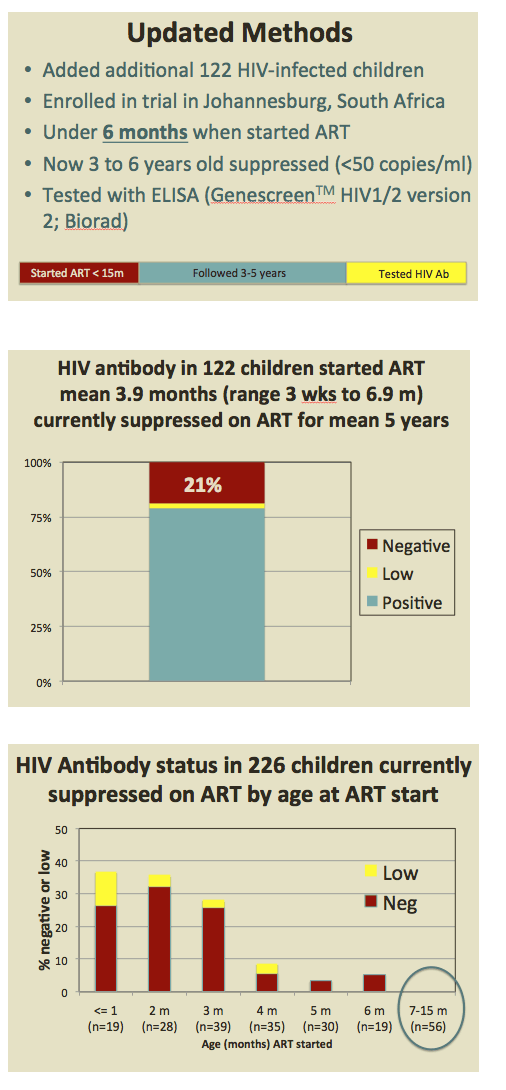 |
 |
 |
| |
Successful ART Started Under Age 6
Months More Likely to Yield Negative Antibody Test
|
| |
| |
20th International AIDS Conference, July 20-25, 2014, Melbourne
Mark Mascolini
Almost one third of South African children who started antiretroviral therapy (ART) in the first 6 months of life and maintained an undetectable viral load had a negative or low HIV antibody test result [1]. Starting ART in the first 3 months of life yielded negative antibody results more often than starting between 4 and 6 months of age. No children who started ART after 6 months of age had a negative antibody result.
HIV-infected children starting ART early in life and maintaining an undetectable viral load sometimes have a negative HIV antibody test after prolonged treatment. The Mississippi baby, who began ART within 30 hours of birth, reached an undetectable viral load with ART, and maintained an undetectable load after ART stopped for a little over 2 years, was antibody-negative [2]. But the frequency of antibody negativity in children who respond to early ART is unknown. Columbia University researchers and others working in South Africa noted that negative antibody test results in children with confirmed HIV infection can be confusing in clinical practice.
To get a better idea of how many promptly treated children achieve negative antibody status or low antibody levels, Louise Kuhn and colleagues studied HIV-infected children enrolled in one of their clinical trials in Johannesburg, South Africa. The investigators selected 104 samples from children who had an undetectable viral load on ART taken for an average 5 years (range 3.4 to 6.4). The children, now 3 to 6 years old, started ART before the age of 15 months, with the starting age averaging 8 months and ranging from 2.2 to 15 months. The research team tested all children for HIV antibody with a standard ELISA assay.
Five of the 104 children (4.8%) tested negative on ELISA and 2 (1.9%) had low antibody reactivity. All 7 children with a negative or low antibody result (6.7% of 104) were younger than 6 months when ART began. In these 7 children, ART starting age averaged 3.7 months and ranged from 2.2 to 4.9 months. Among all 43 children who started ART in the first 6 months of life, only these 7 (16.3%) had a negative or low antibody result.
ART duration did not affect chances of antibody detection. Optical density, which approximates antibody quantity, was significantly lower in 43 children who started ART in the first 6 months of life than in the 61 who started at an older age (average HIV antibody optical density 3.6 versus 4.7 optical density units, P = 0.0002).
The researchers then identified another 122 children in their clinical trials who were younger than 6 months old when they started ART and currently had an on-treatment viral load below 50 copies for an average 5 years. These children averaged 3.9 months in age when they started ART. Of these 122 children, now 3 to 6 years, old, 21% had a negative or low antibody test result.
Next the investigators combined data from the two study groups totaling 226 children. Among 86 children who started ART in the first 3 months of life, about 30% had a negative HIV antibody test. Among 84 children who started treatment at 4 to 6 months of age, about 5% were antibody-negative. None of 56 children who started ART between 7 and 15 months of age had a negative antibody test.
The research team concluded that "a sizeable proportion" of children who start ART before 6 months of age had a negative standard antibody test later in life if they maintained an undetectable viral load. Clinically, they cautioned, using a standard antibody test in children treated early in life "can lead to confusion."
Although the clinical significance of antibody negativity in such children remains unknown, the researchers proposed "it suggests that early treatment may have influenced the ontogeny [development] of antibody responses . . . which may be related to the establishment of viral reservoirs." They believe these findings "imply that early treatment for infants is likely to be beneficial."
References
1. Kuhn L, Schramm D, Shiau S, et al. HIV antibody detection in children who started antiretroviral treatment in infancy. AIDS 2014. 20th International AIDS Conference. July 20-25, 2014. Melbourne. Abstract TUAB0202.
2. Persaud D, Gay H, Ziemniak C, et al. Absence of detectable HIV-1 viremia after treatment cessation in an infant. N Engl J Med. 2013;369:1828-1835. http://www.natap.org/2013/HIV/102813_05.htm
-------------------------------



|
| |
|
 |
 |
|
|